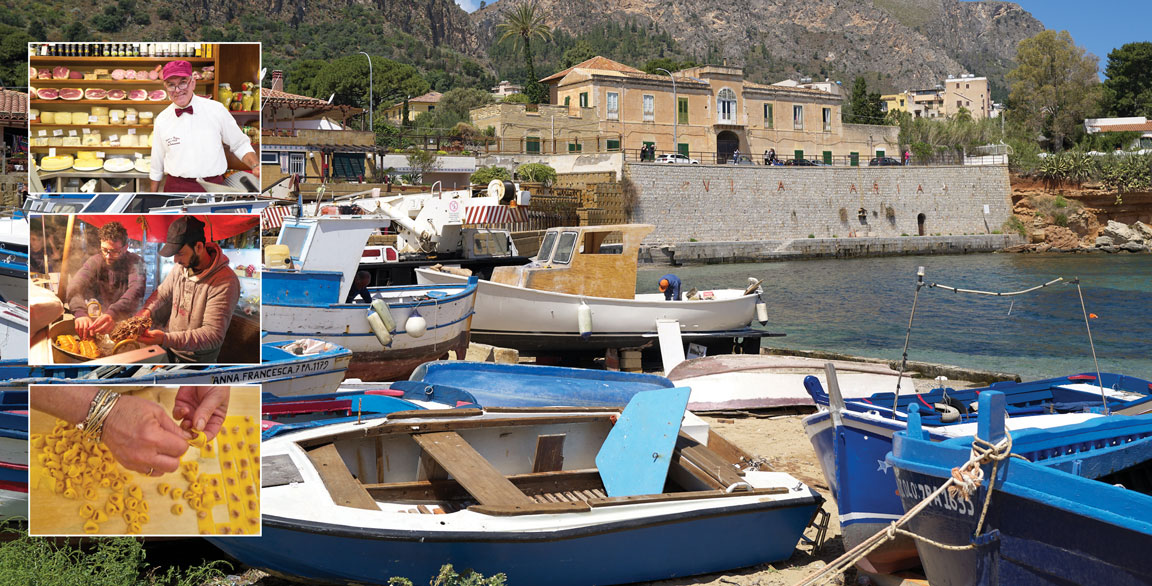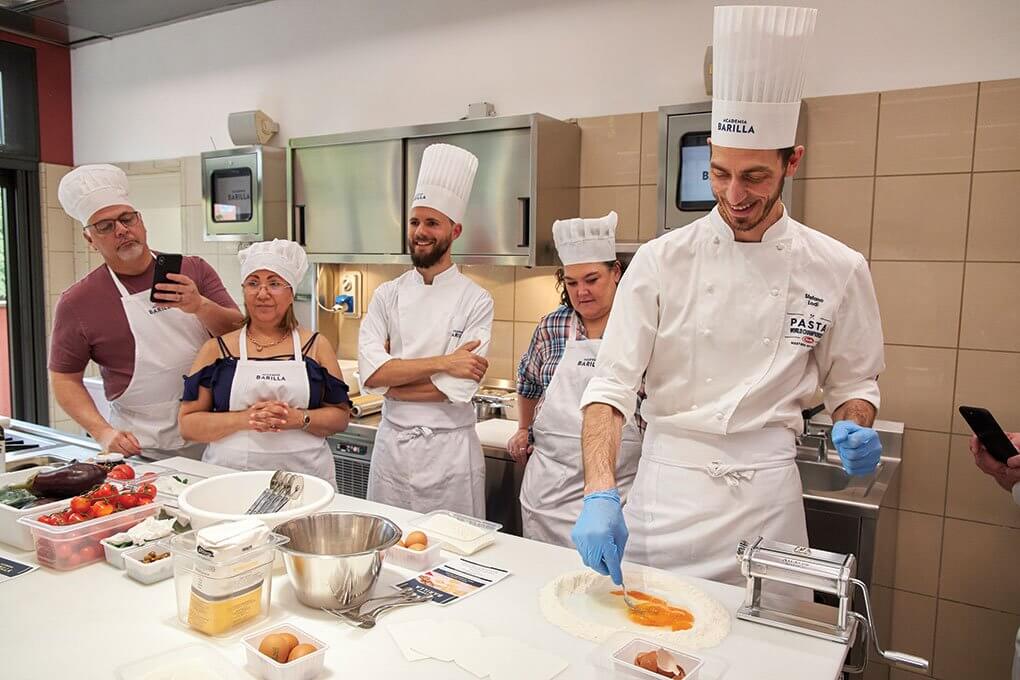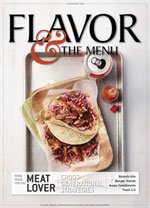
In May, a lucky group of six Flavor & The Menu readers—all winners of Barilla’s culinary tour sweepstakes—packed their bags for a 6-day culinary adventure in Italy.
For this group of foodservice professionals, the journey indulged the senses from start to finish, with visits to some of the country’s finest purveyors, tastes of its iconic foods, and exclusive encounters with a host of Italy’s most revered chefs.
 Roger Paperno
Roger Paperno Tour stops included a visit to Bonini’s balsamic vinegar factory, a Parmigiano-Reggiano cheese plant, and the lively Balistreri brothers’ restaurant Al Faro Verde (left to right)
The tour undoubtedly possessed street cred, commencing in the city of Palermo on the island of Sicily—a destination heralded for having the best street food on earth. Here, inexpensive fare served straight off the cart was born of necessity and preceded food trends by centuries.
Friggitorie (fried-food stalls) lining open-air markets are manned by raucous servers promoting foods that speak directly to Sicily’s delicious blend of cultural roots.
This was a spiritual culinary pilgrimage that blessed us with the privilege of witnessing legendary, centuries-old crafts. There’s nothing like experiencing the tastes, smells, sights and sounds in person.
Chef Bill Brizzolara
Arabs, Normans, Spanish, Greeks and Berbers all imbued food tradition with their trademark spices, be it saffron in arancini (rice balls) bulging with ragù, cured meats and cheeses, or the hint of mint detected in the creamed potato filling of fried crocchè.
Bobbing atop hot vats of oil, triangles of crisp, chickpea-flour fritters, panelle, give nod to North Africa, as do the inclusion of pine nuts, lemon peel, and cinnamon in many local dishes.
Poverty gave birth to nose-to-tail pragmatism, best displayed by the famed pani ca’ meusa, a stew of lard-softened beef spleen and lung served up in a sandwich prepared by none other than the “King of Vucciria” himself, Rocky Basile.
A museum dedicated to one of the island’s ocean stars, the humble anchovy, provided an eclectic peek at Sicily’s fishing industry, accompanied with musical entertainment by the museum curator, who serenades visitors with a guitar festooned by anchovy-can labels.
One of the culinary takeaways for me is to keep things simple. When you start with such great products it is not necessary to muddle things up with extra ingredients. This will definitely influence my cooking style going forward.
Chef Alison Peters
But it was the tasting lunch served seaside at Al Faro Verde in Porticello, just outside Palermo, that most clearly anchored these visiting chefs in local cuisine.
The chef-owner Balistreri brothers invited the group behind kitchen doors to watch a preparation of swordfish “flan.” The hearty white fish was packaged in paper-thin eggplant, lightly fried and sided with a basil-herb cream sauce infused with Sicily’s signature capers and almonds.
A full tasting menu of seafood ensued, ranging from roasted octopus with creamed potato and Barilla gnocchetti with red mullet, shrimp and selvatic fennel, to a polpette di acciughe, an anchovy “meatball” blended with raisins, pine nuts and breadcrumbs.
A tour of Sicily’s food culture wouldn’t be complete without its biggest claim to fame, cannoli. At Palermo’s renowned pasticceria, Costa, legendary are both the cannolo (the singular term for cannoli) and famed Easter treat, cassata—a liquor-soaked sponge cake so elaborately decorated that it makes Easter eggs look downright dismal.
A key ingredient for both: fresh ricotta.
Still bearing telltale strainer imprints, the group watched as the pastry chef folded the soft cheese into just enough sugar to balance out its saltiness before introducing it into the carefully blistered tube of fried pastry finished with candied orange.
After this deep dive into Sicilian cuisine, which included a stay at the palazzo owned by winemaking royalty, the Planeta family (who shared varietals ranging from tropical Fiano to velvety Nocera), it was time to move on to the mainland. Italy’s food belt, Emilia-Romagna, was a logical choice given that it’s the epicenter for all things fat and flavorful.
Whether twirling tortellini around their fingers next to the famed sfogline (women pasta makers of Bologna), or attending class with a gelato master at Carpigiani Gelato University, or delving into the aging process of balsamic vinegar, the group witnessed a strict adherence to tradition.
No pilgrimage to Emilia-Romagna is complete without paying homage to Parmigiano-Reggiano. This included visiting a plant that took the brunt of two earthquakes in 2012, sending more than 360,000 wheels of cheese tumbling to the ground.
Of great interest for the group was how Emilia-Romagna’s ingredients manifested on the plate. In Modena, this meant slipping behind the deli counter to snag one of the toughest reservations in town, a private back room at Hosteria Giusti.
In Bologna, the meal du jour was from restaurant Drogheria della Rosa. Set within a former pharmacy, seasonal dishes relayed by owner Emanuele Addone included falling-off-the-bone pork osso buco and tortellini stuffed with squacquerone and stracchino cheeses sautéed with squash blossoms.
 Roger Paperno
Roger Paperno In Parma, chefs were guided through traditional Italian recipes at Academia Barilla.
Cortex Bistrot in Parma foregoes fine-dining formalities, employing molecular innovation and global twists on tradition, with creative takes atypical of the area’s eateries: a delicate egg yolk floating amid Parmesan foam and porcini dust, or spring lamb and fresh mint balanced with yogurt and spicy kimchi.
Emilia-Romagna is also home to Barilla, founded in the town of Parma in 1877. Today, what was once a small pasta purveyor has morphed into the world’s largest empire for dried pasta production. Despite the countless configurations of dried semolina being packaged into the iconic blue boxes, the family upholds a dogmatic dedication to quality.
Sustainability takes center stage, as does a zero-tolerance for GMOs.
Going to the actual place where the food originated is very different than seeing an interpretation from someone else. I look forward to building more authenticity into our dishes so that they better reflect their origins.
Chef Matt Harding
And while chefs like Massimo Bottura may have put Emilia-Romagna on the culinary map, the highlight for this group of chefs was the day spent at Academia Barilla in Parma, which serves as the pasta company’s cultural center for the promotion of Italian gastronomy.
Here, Barilla chef Stefano Lodi showed the group how to best harness Italian flavors through tradition and simplicity.
 Roger Paperno
Roger Paperno The tastes of Italy, from the hands of the experts: Chef Maurizio Balistreri’s eggplant-swordfish roll with basil cream sauce; Barilla chef Stefano Lodi masters ribbons of pasta; connolo in perfect execution at Costa in Palermo, and clay-baked guinea fowl at chef Massimo Spigaroli’s Antica Corte Pallavicina.
Chefs worked with him to cut wide ribbons of squid-ink dough into tagliolini later tossed with wine-bathed clams and shrimp, and pair mezze maniche rigate (rigatoni’s stocky brother) with a guinea-hen ragù that typified spring terroir.
Though local trattorias may leave one believing that cured meats and aged Parmesan always take center stage, Academia chefs revealed how even sautéed vegetables can make spotlight-stealing cameos in a mélange of produce tucked into puff pastry.
The day spent at Academia Barilla was an appropriate cap to the trip, manifesting all that the chefs had taken in over the duration of the tour. Here, they were reminded of what it’s like to experience food anew, and how taste can transcend language barriers. It also instilled in them a sense of place that will be delivered directly to their customers at home.
 Roger Paperno
Roger Paperno 






 From the July-August 2019 issue of Flavor & The Menu magazine
From the July-August 2019 issue of Flavor & The Menu magazine